
Shoot 'em ups are a sub-genre of action games. There is no consensus as to which design elements compose a shoot 'em up; some restrict the definition to games featuring spacecraft and certain types of character movement, while others allow a broader definition including characters on foot and a variety of perspectives.

Namco Limited was a Japanese multinational video game and entertainment company, headquartered in Ōta, Tokyo. It held several international branches, including Namco America in Santa Clara, California, Namco Europe in London, Namco Taiwan in Kaohsiung, and Shanghai Namco in mainland China.
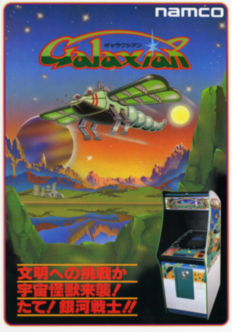
Galaxian is a 1979 fixed shooter arcade video game developed and published by Namco. The player assumes control of the Galaxip starfighter in its mission to protect Earth from waves of aliens. Gameplay involves destroying each formation of aliens, who dive down towards the player in an attempt to hit them.
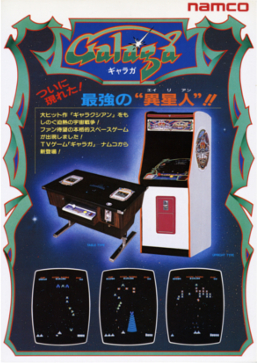
Galaga is a 1981 fixed shooter arcade video game developed and published by Namco. In North America, it was released by Midway Manufacturing. It is the sequel to Galaxian (1979), Namco's first major video game hit in arcades. Controlling a starship, the player is tasked with destroying the Galaga forces in each stage while avoiding enemies and projectiles. Some enemies can capture a player's ship via a tractor beam, which can be rescued to transform the player into a "dual fighter" with additional firepower.
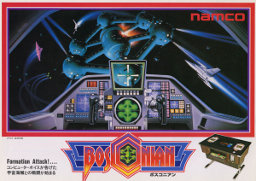
Bosconian is a multidirectional scrolling shooter arcade game which was developed and released by Namco in Japan in 1981. In North America, it was manufactured and distributed by Midway Games. The goal of the game is to earn as many points as possible by destroying enemy missiles and bases using a ship which shoots from both the front and back. Bosconian became the first shoot 'em up game to feature diagonal movement.

Silpheed is a video game developed by Game Arts and designed by Takeshi Miyaji. It made its debut on the Japanese PC-8801 in 1986, and was ported to the Fujitsu FM-7 and DOS formats soon after. It was later remade for the Sega CD and has a sequel called Silpheed: The Lost Planet for the PlayStation 2.

Galaga '88 is a 1987 fixed shooter arcade video game by Namco. It is the third sequel for Galaxian. It features significantly improved graphics over the previous games in the series, including detailed backgrounds, larger enemies and greater ship details. The game runs on Namco System 1 hardware.
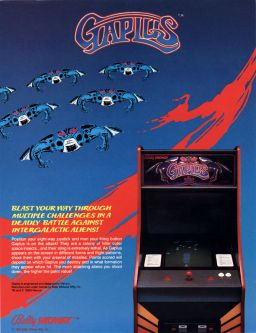
Gaplus is a 1984 fixed shooter arcade game developed and released by Namco. It is the third game in the Galaxian series, serving as a direct sequel to Galaga (1981). In North America, a modification kit was later released to change the name to Galaga 3, possibly to reflect its position in the series. It was the only game other than Phozon to run on the Namco Phozon hardware. A contemporary home port for the Commodore 64 was released in 1988. A "demastered" version of the game was included in Namco Museum Archives Vol. 2 as a bonus title.
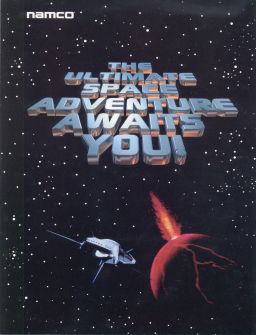
Galaxian3: Project Dragoon is a 3D rail shooter video game developed and published by Namco. It was originally a theme park attraction designed for the International Garden and Greenery Exposition in Japan, and was later released as an arcade game in 1992. The game involves players controlling a starship named the Dragoon in its mission to destroy Cannon Seed, a superweapon set to destroy what is left of the human race.

Super Xevious is a 1984 vertical-scrolling shooter arcade game developed and published by Namco in Japan. It is an updated version of Xevious (1983) released as conversion kit for existing Xevious cabinets, created as a response to the overwhelming success of the original in Japan. Like the original game, the player controls a starship known as the "Solvalou", equipped with two weapons: an "air zapper" to defeat flying enemies, and a "blaster bomb" to destroy ground-based enemies. It runs on the Namco Galaga arcade board. New enemy types include metallic Galaxian flagships. Some of these revert the player's score to zero if destroyed. It has been ported to the Sharp X68000 and PlayStation, alongside inclusion in several Namco collections.

Namco Classic Collection Vol. 1 is a 1995 arcade game compilation developed and published by Namco. It includes three of the company's most well-known games from the early 1980s — Galaga (1981), Xevious (1983), and Mappy (1983) — alongside brand-new "Arrangement" remakes of these games that have updated gameplay, visuals, and sounds. The arcade originals are also modified slightly to end after a certain number of rounds. Super Xevious (1984) is also playable. It ran on the Namco ND-1 arcade system, being one of the first games to utilize it.
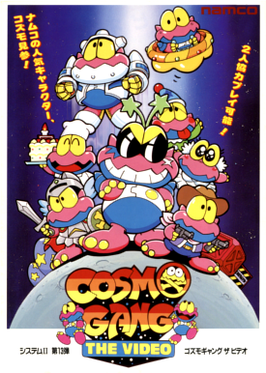
Cosmo Gang the Video is a 1992 fixed shooter arcade game developed and published by Namco. A home conversion for the Super Famicom was released the same year. Controlling the Hyper Beat starship, the player is tasked with ridding the galaxy of the Cosmo Gang, a race of aliens that cause mischief across Earth. Gameplay involves shooting enemies and avoiding projectiles. Power-up items can be collected to grant the player additional abilities. It ran on the Namco System 2 arcade board.

Starblade is a 1991 3D rail shooter arcade game developed and published by Namco. Controlling the starfighter FX-01 "GeoSword" from a first-person perspective, the player is tasked with eliminating the Unknown Intelligent Mechanized Species (UIMS) before they wipe out Earth. Gameplay involves controlling a crosshair with a flight yoke stick and destroying enemies and their projectiles before they inflict damage on the player.

Galaga Legions is a 2008 twin-stick shooter video game developed and released by Namco Bandai Games for the Xbox 360. It is the twelfth game in the Galaxian series, and the third developed for home platforms. The player controls a starship, the AEf-7 "Blowneedle", in its efforts to wipe out the Galaga armada. The objective of the game is to clear each of the five stages as quick as possible. Stages have a heavy emphasis on puzzle solving and chain reactions, which are necessary to clear out enemy formations. The Blowneedle has a pair of satellites at its disposal, and can place them anywhere on the screen to fend off enemies.
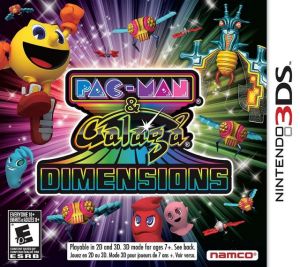
Pac-Man & Galaga Dimensions is a 2011 video game compilation developed and published for the Nintendo 3DS by Namco Bandai Games. It contains six games from the company's Pac-Man and Galaxian franchises—Pac-Man (1980), Galaga (1981), Pac-Man Championship Edition (2007), Galaga Legions (2008), Pac-Man Tilt, and Galaga 3D Impact, the last two being unique games created exclusively for this collection. The collection also includes achievements, online leaderboards, and a trailer for the Pac-Man and the Ghostly Adventures television series.
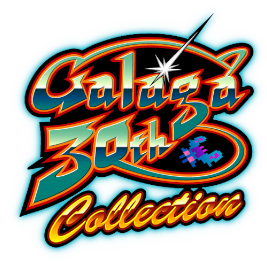
Galaga 30th Collection is a 2011 video game compilation published for iOS devices by Namco Bandai Games. It was created to commemorate the 30th anniversary of Galaga.

Galaga Legions DX is a 2011 twin-stick shooter video game developed and published by Namco Bandai Games for the Xbox 360 and PlayStation 3. It is the sequel to Galaga Legions (2008), and is the fourteenth entry in the Galaxian series. The player controls the AEf-7 "Blowneedle" starship in its efforts to wipe out the Galaga forces before they destroy all of mankind. The objective is to clear each of the game's nine stages in the quickest time possible by destroy waves of enemies. The Blowneedle has a pair of satellites that can be pointed at enemies to shoot them down. New additions have been made to the core gameplay, such as a "slowdown" effect when the player is about to collide with an enemy.

Final Blaster is a 1990 vertical-scrolling shooter video game developed by Nova and published by Namco for the PC-Engine. Controlling the Blaster Mark II "Phoenix" starfighter, the player is tasked with wiping out the Bosconian alien race before they destroy Earth. Gameplay involves shooting down enemies and avoiding projectiles — power-ups can be collected to increase the player's abilities. It is the third and final game in Namco's Bosconian series.

Power Strike II is a 1993 vertically scrolling shooter video game developed by Compile and published by Sega for the Game Gear. An entry in the Aleste series, it is a follow-up to GG Aleste (1991). The game follows Alice Waizen piloting the Lance Bird space fighter craft to stop an unknown parasitic object attached to the armored defense satellite Algo. Its gameplay is similar to the previous Aleste entry on Game Gear, with the player fighting enemies and bosses, while avoiding collision with their projectiles and other obstacles.



















